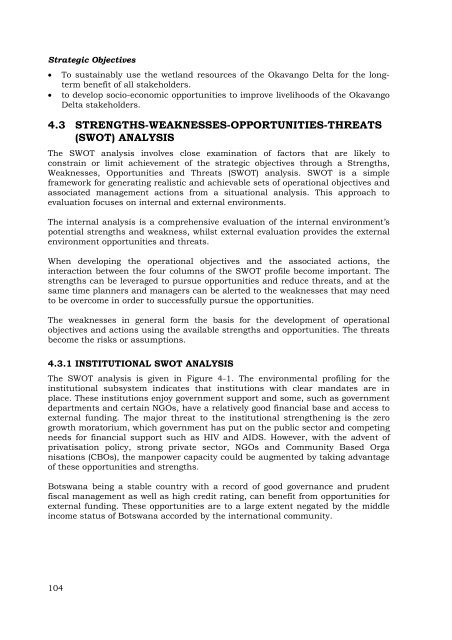Okavango Delta Management Plan - Ramsar Convention on Wetlands
Okavango Delta Management Plan - Ramsar Convention on Wetlands
Okavango Delta Management Plan - Ramsar Convention on Wetlands
You also want an ePaper? Increase the reach of your titles
YUMPU automatically turns print PDFs into web optimized ePapers that Google loves.
Strategic Objectives<br />
• To sustainably use the wetland resources of the <str<strong>on</strong>g>Okavango</str<strong>on</strong>g> <str<strong>on</strong>g>Delta</str<strong>on</strong>g> for the l<strong>on</strong>gterm<br />
benefit of all stakeholders.<br />
• to develop socio-ec<strong>on</strong>omic opportunities to improve livelihoods of the <str<strong>on</strong>g>Okavango</str<strong>on</strong>g><br />
<str<strong>on</strong>g>Delta</str<strong>on</strong>g> stakeholders.<br />
4.3 STRENGTHS-WEAKNESSES-OPPORTUNITIES-THREATS<br />
(SWOT) ANALYSIS<br />
The SWOT analysis involves close examinati<strong>on</strong> of factors that are likely to<br />
c<strong>on</strong>strain or limit achievement of the strategic objectives through a Strengths,<br />
Weaknesses, Opportunities and Threats (SWOT) analysis. SWOT is a simple<br />
framework for generating realistic and achievable sets of operati<strong>on</strong>al objectives and<br />
associated management acti<strong>on</strong>s from a situati<strong>on</strong>al analysis. This approach to<br />
evaluati<strong>on</strong> focuses <strong>on</strong> internal and external envir<strong>on</strong>ments.<br />
The internal analysis is a comprehensive evaluati<strong>on</strong> of the internal envir<strong>on</strong>ment’s<br />
potential strengths and weakness, whilst external evaluati<strong>on</strong> provides the external<br />
envir<strong>on</strong>ment opportunities and threats.<br />
When developing the operati<strong>on</strong>al objectives and the associated acti<strong>on</strong>s, the<br />
interacti<strong>on</strong> between the four columns of the SWOT profile become important. The<br />
strengths can be leveraged to pursue opportunities and reduce threats, and at the<br />
same time planners and managers can be alerted to the weaknesses that may need<br />
to be overcome in order to successfully pursue the opportunities.<br />
The weaknesses in general form the basis for the development of operati<strong>on</strong>al<br />
objectives and acti<strong>on</strong>s using the available strengths and opportunities. The threats<br />
become the risks or assumpti<strong>on</strong>s.<br />
4.3.1 INSTITUTIONAL SWOT ANALYSIS<br />
The SWOT analysis is given in Figure 4-1. The envir<strong>on</strong>mental profiling for the<br />
instituti<strong>on</strong>al subsystem indicates that instituti<strong>on</strong>s with clear mandates are in<br />
place. These instituti<strong>on</strong>s enjoy government support and some, such as government<br />
departments and certain NGOs, have a relatively good financial base and access to<br />
external funding. The major threat to the instituti<strong>on</strong>al strengthening is the zero<br />
growth moratorium, which government has put <strong>on</strong> the public sector and competing<br />
needs for financial support such as HIV and AIDS. However, with the advent of<br />
privatisati<strong>on</strong> policy, str<strong>on</strong>g private sector, NGOs and Community Based Orga<br />
nisati<strong>on</strong>s (CBOs), the manpower capacity could be augmented by taking advantage<br />
of these opportunities and strengths.<br />
Botswana being a stable country with a record of good governance and prudent<br />
fiscal management as well as high credit rating, can benefit from opportunities for<br />
external funding. These opportunities are to a large extent negated by the middle<br />
income status of Botswana accorded by the internati<strong>on</strong>al community.<br />
104

















